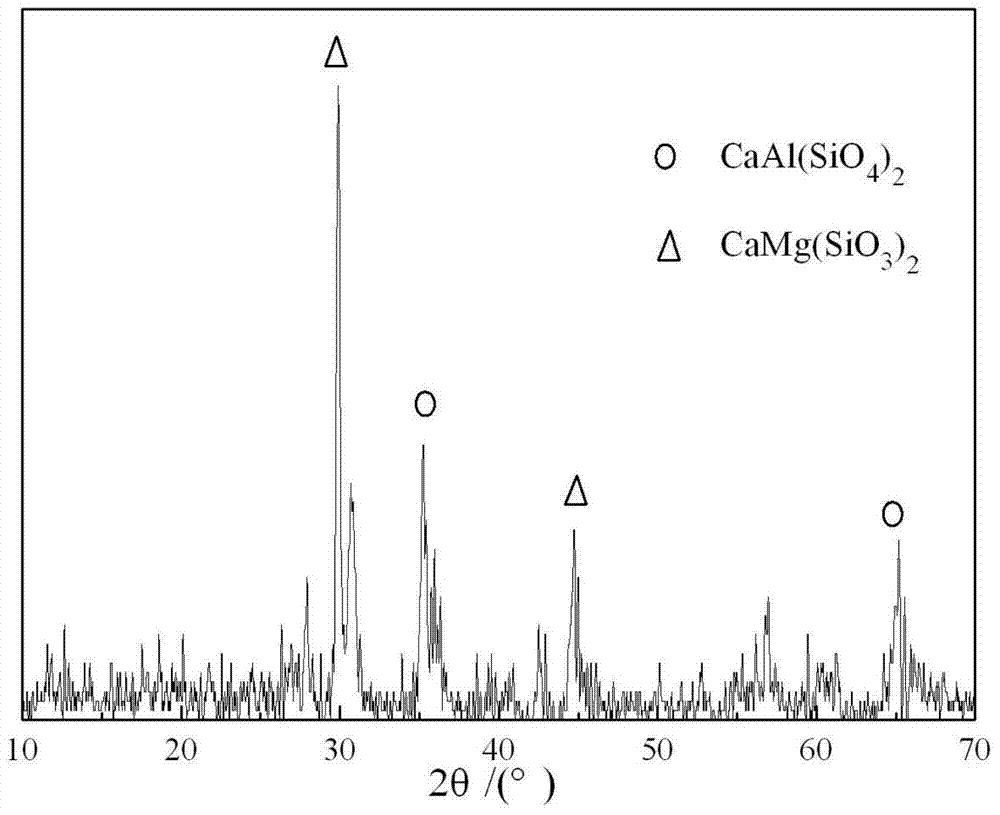Glass ceramic and float producing process thereof
A technology of glass-ceramic and production process, applied in glass production and other directions, can solve the problems of environmental pollution, high production cost, low production efficiency, etc., and achieve the effects of reducing production cost, convenient forming process, and improving production efficiency
- Summary
- Abstract
- Description
- Claims
- Application Information
AI Technical Summary
Problems solved by technology
Method used
Image
Examples
Embodiment 1
[0030] Raw material composition: CaO 5kg, MgO 9kg, Al 2 o 3 24kg, SiO 2 50kg, Na 2 O 4kg, K 2 O 2.5kg, ZnO 1kg, TiO 2 3kg, ZrO 2 1.5kg.
[0031] 1) The raw materials are weighed and mixed evenly in proportion, placed in a glass melting furnace and heated to 1560°C for melting and homogenization;
[0032] 2) The melted and homogenized glass enters the surface of the tin bath through the forehearth and is flattened at 1300°C, polished at 1170°C, and then thinned at 1005°C to obtain a 4mm thick glass ribbon. After the glass ribbon is cooled to 700°C Leave the tail end of the tin bath and enter the heat treatment kiln;
[0033] 3) After the glass ribbon enters the heat treatment furnace, it is nucleated at 730°C for 20 minutes, crystallized at 940°C for 45 minutes; uniformly annealed at 650°C for 20 minutes;
[0034] 4) After the glass is taken out of the heat treatment kiln, it is cut and polished to obtain the desired product.
Embodiment 2
[0036] Raw material composition: CaO 9kg, MgO 4kg, Al 2 o 3 16kg, SiO 2 54kg, Na 2 O 7kg, K 2 O 6kg, ZnO 0.5kg, TiO 2 2.5kg, ZrO 2 1kg.
[0037] 1) The raw materials are weighed and mixed evenly in proportion, placed in a glass melting furnace and heated to 1520°C for melting and homogenization;
[0038] 2) The melted and homogenized glass enters the surface of the tin bath through the forehearth and is flattened at 1280°C, polished at 1120°C, and then stacked at 995°C to obtain a 10mm thick glass ribbon. After the glass ribbon is cooled to 720°C Leave the tail end of the tin bath and enter the heat treatment kiln;
[0039] 3) After the glass ribbon enters the heat treatment furnace, it is nucleated at 720°C for 40 minutes, crystallized at 915°C for 48 minutes, and uniformly annealed at 620°C for 30 minutes;
[0040] 4) After the glass is taken out of the heat treatment kiln, it is cut and polished to obtain the desired product.
Embodiment 3
[0042] Raw material composition: CaO 8kg, MgO 8kg, Al 2 o 3 16kg, SiO 2 47kg, Na 2 O 3kg, K 2 O 7kg, ZnO 0.5kg, TiO 2 7kg, ZrO 2 3.5kg.
[0043] 1) The raw materials are weighed and mixed evenly in proportion, placed in a glass melting furnace and heated to 1500°C for melting and homogenization;
[0044] 2) The melted and homogenized glass enters the surface of the tin bath through the forehearth and is flattened at 1250°C, polished at 1173°C, and then stacked at 1000°C to obtain a 17mm thick glass ribbon. After the glass ribbon is cooled to 670°C Leave the tail end of the tin bath and enter the heat treatment kiln;
[0045] 3) After the glass ribbon enters the heat treatment furnace, it is nucleated at 700°C for 48 minutes, crystallized at 960°C for 54 minutes; uniformly annealed at 600°C for 45 minutes;
[0046] 4) After the glass is taken out of the heat treatment kiln, it is cut and polished to obtain the desired product.
PUM
 Login to View More
Login to View More Abstract
Description
Claims
Application Information
 Login to View More
Login to View More - R&D
- Intellectual Property
- Life Sciences
- Materials
- Tech Scout
- Unparalleled Data Quality
- Higher Quality Content
- 60% Fewer Hallucinations
Browse by: Latest US Patents, China's latest patents, Technical Efficacy Thesaurus, Application Domain, Technology Topic, Popular Technical Reports.
© 2025 PatSnap. All rights reserved.Legal|Privacy policy|Modern Slavery Act Transparency Statement|Sitemap|About US| Contact US: help@patsnap.com

